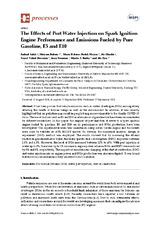The Effects of Port Water Injection on Spark Ignition Engine Performance and Emissions Fueled by Pure Gasoline, E5 and E10
Autor
Salek, Farhad
Babaie, Meisam
Redel-Macías, María Dolores
Ghodsi, Ali
Hosseini, Seyed Vahid
Nourian, Amir
Burby, Martin L
Zare, Ali
Editor
MDPIFecha
2020Materia
E10 biofuelEthanol
NOx
Water port injection
Start of combustion
METS:
Mostrar el registro METSPREMIS:
Mostrar el registro PREMISMetadatos
Mostrar el registro completo del ítemResumen
It has been proven that vehicle emissions such as oxides of nitrogen (NOx) are negatively affecting the health of human beings as well as the environment. In addition, it was recently highlighted that air pollution may result in people being more vulnerable to the deadly COVID-19 virus. The use of biofuels such as E5 and E10 as alternatives of gasoline fuel have been recommended by different researchers. In this paper, the impacts of port injection of water to a spark ignition engine fueled by gasoline, E5 and E10 on its performance and NOx production have been investigated. The experimental work was undertaken using a KIA Cerato engine and the results were used to validate an AVL BOOST model. To develop the numerical analysis, design of experiment (DOE) method was employed. The results showed that by increasing the ethanol fraction in gasoline/ethanol blend, the brake specific fuel consumption (BSFC) improved between 2.3% and 4.5%. However, the level of NOx increased between 22% to 48%. With port injection of water up to 8%, there was up to 1% increase in engine power whereas NOx and BSFC were reduced by 8% and 1%, respectively. The impacts of simultaneous changing of the start of combustion (SOC) and water injection rate on engine power and NOx production was also investigated. It was found that the NOx concentration is very sensitive to SOC variation.

